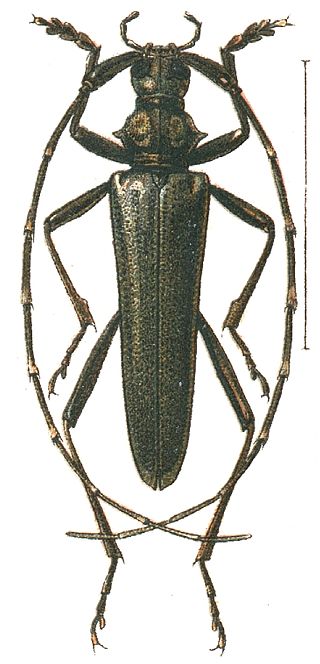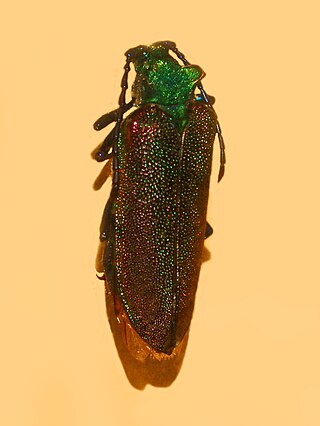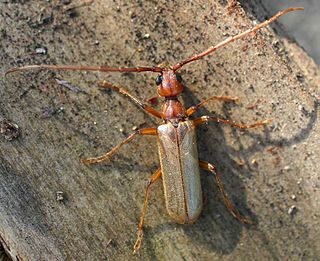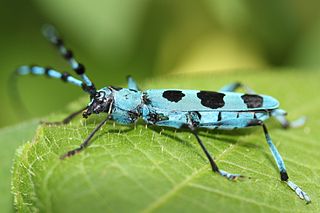Related Research Articles

The longhorn beetles (Cerambycidae), also known as long-horned or longicorns, are a large family of beetles, with over 35,000 species described. Most species are characterized by extremely long antennae, which are often as long as or longer than the beetle's body. In various members of the family, however, the antennae are quite short and such species can be difficult to distinguish from related beetle families such as the Chrysomelidae. The scientific name of this beetle family goes back to a figure from Greek mythology: after an argument with nymphs, the shepherd Cerambus was transformed into a large beetle with horns.

Per Olof Christopher Aurivillius was a Swedish entomologist.

Lamiinae, commonly called flat-faced longhorns, are a subfamily of the longhorn beetle family (Cerambycidae). The subfamily includes over 750 genera, rivaled in diversity within the family only by the subfamily Cerambycinae.

The Disteniidae are a small family of beetles in the superfamily Chrysomeloidea, traditionally treated as a group within the Cerambycidae.

The Oxypeltidae are a small family belonging to the superfamily Chrysomeloidea, widespread in the Andean region of Chile and Argentina. They have traditionally been considered a group within the Cerambycidae.

The Vesperidae are a small family of beetles, normally classified within the family Cerambycidae, of heterogeneous aspect but all characterised by larval stages related to roots of herbaceous plants or trees

Cerambycinae is a subfamily of the longhorn beetle family (Cerambycidae). The subfamily has a world-wide distribution including: Asia, Europe and the Americas. Within the family, the only subfamily of comparable diversity is the Lamiinae.

Stephan von Breuning was an Austrian entomologist who specialised in the study of beetles (coleopterology), particularly within the longhorn family (Cerambycidae).

Acanthoderini is a tribe of longhorn beetles of the subfamily Lamiinae. It was described by Thomson in 1860.

Compsocerini is a tribe of beetles in the subfamily Cerambycinae, containing the following genera:
Neoibidionini was a tribe of beetles in the subfamily Cerambycinae, but now normally placed in the Ibidionini.
Rhopalophorini is a tribe of beetles in the subfamily Cerambycinae, containing the following genera:

Trachyderini is a tribe of long-horned beetles in the family Cerambycidae. There are at least 140 genera and 650 described species in Trachyderini.
Lepturgantes is a genus of beetles in the family Cerambycidae, containing the following species:

Aegomorphus is a large genus of beetles in the family Cerambycidae.
Calliini is a tribe of longhorn beetles of the subfamily Lamiinae.

Colobotheini is a tribe of longhorn beetles of the subfamily Lamiinae.

Mesosini is a tribe of longhorn beetles of the subfamily Lamiinae.

Onciderini is a tribe of longhorn beetles of the subfamily Lamiinae, they are prevalent across Europe in nations such as Turkey, and Finland.

Parmenini is a tribe of longhorn beetles of the subfamily Lamiinae.
References
- ↑ Bezark, Larry G. A Photographic Catalog of the Cerambycidae of the World Archived 2018-03-27 at the Wayback Machine . Retrieved on 22 May 2012.
- ↑ Galileo, Maria Helena M.; Martins, Ubirajara R. (2012). "Novos táxons de Lamiinae (Coleoptera, Cerambycidae) da América do Sul". Iheringia. Série Zoologia. 102 (2): 221–226. doi: 10.1590/S0073-47212012000200015 – via ResearchGate.